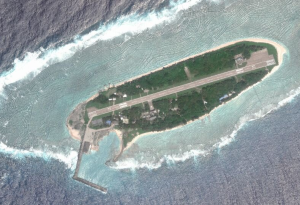As Taiwan’s new President Lai Ching-te settles into office, cross strait relations remain tense as Lai vowed to staunchly oppose “authoritarian expansion” while the Chinese government in Beijing insists upon reunification. Crucial to Taiwan’s struggle for freedom is the cultivation and maintenance of international partnerships. While the United States has demonstrated consistent support for Taiwan, the sheer size of China’s military and the tyranny of distance prompts Taipei to search for more proximate partners.
However, ties with other states in the Indo-Pacific based on common security concerns may prove difficult to develop. This is because Taiwan has also been engaged in longstanding territorial disputes regarding the Senkaku/Diaoyutai Islands, Pratas Island, and Itu Aba. Compounding these difficulties is the fact that both Taiwan and China use the same rationale to justify their claims to these islands.
Taiwan’s claims to the Japanese-administered Senkaku Islands are rooted in historical arguments. Known as the Diaoyutai islands to Taiwan, they were discovered by Ming dynasty China, and forfeited to Japan as part of the Treaty of Shimonoseki. Following World War II, Japan voided the Treaty of Shimonoseki with the Republic of China as part of the terms of surrender, but retained the Senkaku Islands as the ROC did not immediately realize that the Senkaku and Diaoyutai Islands are one and the same.
The United States had reverted the prefecture of Okinawa – which Japan considers to include the Senkaku Islands – to Japanese control in 1972; officially the U.S. does not take a position on the sovereignty of the islands, but it does maintain that any attempt to forcibly contest Japan’s administration of the islands would invoke U.S. security guarantees. The presence of oil and gas reserves and rich fishing waters near the islands make them an important objective for the claimant states.
Taiwan’s diplomatic isolation has made it difficult to make its voice heard on the dispute, but Taipei has made some progress with Japan by undertaking a two-pronged strategy. One facet consists of engaging in peaceful dialogue with overt commitments to resolving the issue through international laws and institutions. The other side of the strategy consists of gray zone tactics, not unlike those that China employs; in the past, Taiwan facilitated activists landing on the Senkaku Islands and dispatched coast guard vessels to harass Japanese ships. Through U.S. nudging, Japan has granted Taiwan some concessions regarding economic activities near the islands. Nonetheless, Taiwan insists that it is the sovereign authority over the Senkaku Islands.
Taiwan’s positions on the South China Sea dispute however, are more ambiguous. Following World War II, both the PRC government in Beijing and the ROC government in Taiwan adopted the U-shaped line claim that encompasses most of the South China Sea. Drawing upon historical precedent, which records extensive use of the sea by Qing dynasty China, both Beijing and Taipei have defended their expansive claims as the legitimate continuation of control exerted by imperial China.
While China has taken aggressive action to occupy and defend its claims, especially in recent years, Taiwan has been more muted. Instead of directly contesting the entirety of the zone, Taiwan is preoccupied with maintaining and defending the landmasses in the area that it has control over, namely, Pratas Island and the Itu Aba Island. Pratas Island and Itu Aba Island are the only two landmasses in the South China Sea that are currently administered by Taiwan. Both islands serve military purposes for Taiwan; they are garrisoned with artillery emplacements, useful for projecting force outward and gathering information.
In addition to China, the Philippines also claims Pratas Island and both Vietnam and the Philippines assert that Itu Aba falls within their respective zone of control. Taiwan has rejected international court rulings that refute Taiwan’s claim to these landmasses, and continues to plan military drills, troop deployments, and official visits to the islands. Under the ruling Democratic Progressive Party (DPP), however, Taiwan’s government has been cautious about overt demonstrations of sovereignty over the islands. Outgoing President Tsai Ing-wen resisted pressure to visit Itu Aba before her term concluded, and Lai avoided mentioning the islands during his inaugural address.
Given the rising tensions in the Taiwan Strait, Lai may be inclined to rethink or clarify Taiwan’s present stances on the longstanding maritime issues it has with other countries. While Japan remains committed to Taiwan’s defense and extended concessions regarding the use of the Senkaku Islands, this was made possible through the United States, and more cooperation is contingent on Taiwanese engagement with Japan. Vietnam and the Philippines do not have such a comparable relationship between them and the United States, and so overtures by Taiwan will be required if Taipei is to develop partnerships.
Taiwan’s position in these disputes is difficult, due to the fact that its claims are tied to being the legitimate inheritor of China. As a result, withdrawal of these claims can serve as political ammunition by Beijing, which will construe any concession as Taiwan taking a pro-independence stance by rejecting a policy throughline with the ROC’s time as the mainland government.
It’s also a sensitive issue domestically, with the opposition Kuomintang (KMT) seeking to pressure the DPP into making overt statements of sovereignty. On May 18, just two days before Lai’s inauguration, a group of KMT-led lawmakers visited Itu Aba and demanded that Lai “publicly reaffirm Taiping Island [Itu Aba] as the Republic of China’s territory.”
In any case, Taiwan must continue to engage in constructive dialogue and desist from aggressive action if Taipei hopes to gain more partners to assist it. Whether Lai opts for retaining the islands or sharing them for humanitarian or economic purposes, Taiwan must take a stance.

































